Your Home Office Doesn’t Have to Hurt: A Real-World Guide to Getting it Right
I spent my early career in a slick design office. You know the type—fancy chairs that cost more than my first car, professional ergonomic checks, the whole nine yards. So when I went solo and started working from home, I figured my laptop on the dining table was good enough. Spoiler alert: it wasn’t. Within three months, my neck was a mess, my wrists ached constantly, and my focus was totally gone. It was a painful lesson, but a valuable one: a home office isn’t just for show. It’s a workspace, and it has to support your health just as much as your job.
In this article
Over the last decade and a half, I’ve set up hundreds of these spaces, from tiny nooks in city apartments to full-blown rooms in the suburbs. And I’ve learned that the core principles for a good setup are always the same. They’re based on how our bodies are built, not on some passing trend you saw on social media. An office that feels good is one that works well. The cool decor and personal touches? That’s the fun part that comes after you’ve built a solid foundation.
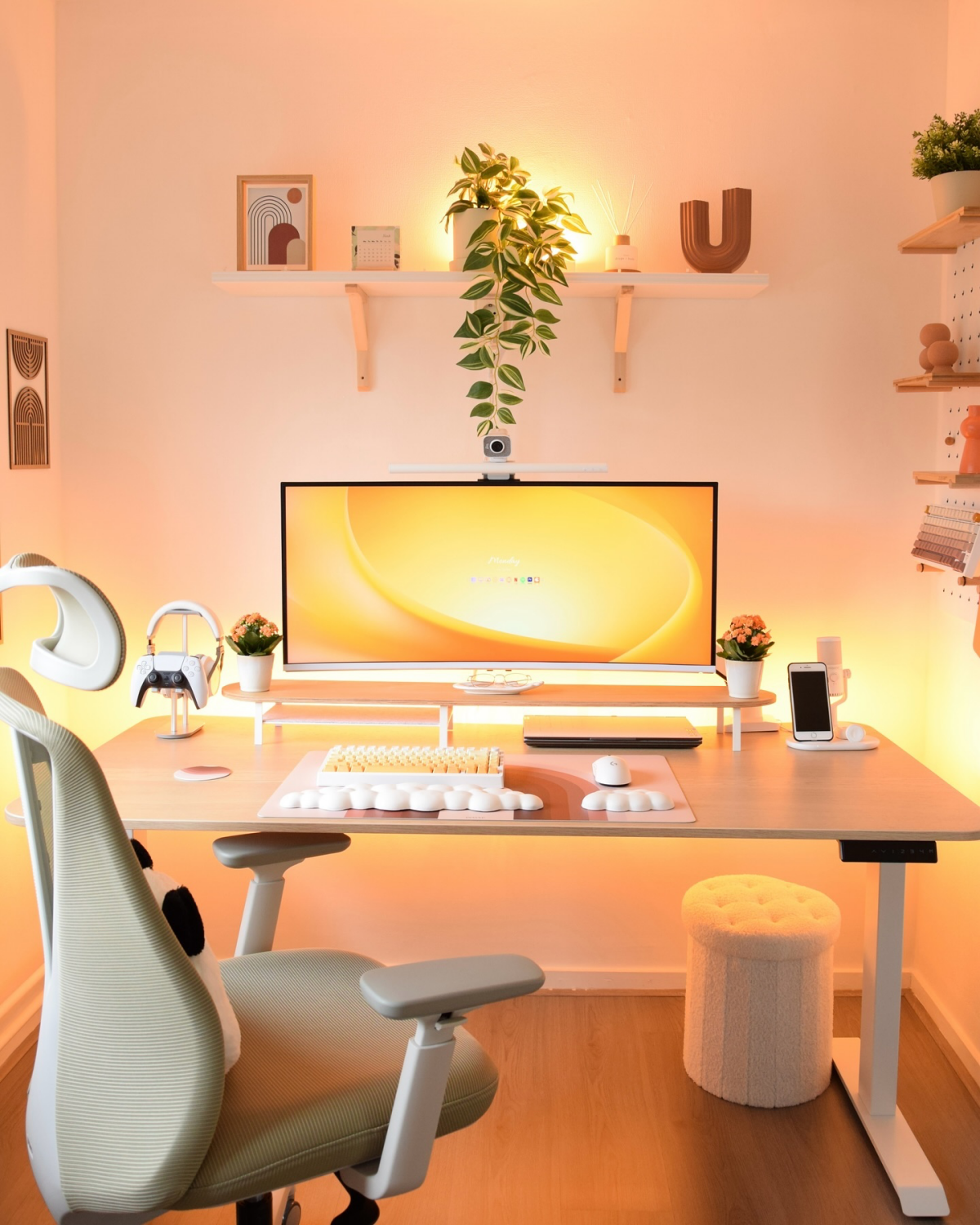
First Things First: Quick Fixes You Can Do Right Now
Before you even think about opening your wallet, let’s talk about some free, two-minute fixes that can make a huge difference today. Seriously, a lot of the worst habits are the easiest to correct.
A super common mistake is working hunched over a laptop on a table. Your screen is too low and your keyboard is attached—it’s an ergonomic nightmare. The quick fix? Grab a stack of sturdy books (or a shoebox, no judgment) and place your laptop on it until the top of the screen is at eye level. Then, find ANY external keyboard and mouse you have lying around and plug them in. Boom. You’ve just instantly improved your posture without spending a dime.
Okay, ready for another one? Stop reading and do this 5-point check right now:
- Are your feet resting flat on the floor?
- Are your knees bent at roughly a 90-degree angle?
- Is your lower back supported by your chair?
- Are your elbows bent at 90 degrees, level with your desk?
- Is the top of your monitor at or just below eye level?
If you had to answer ‘no’ to any of these, just adjust one thing. Go on, I’ll wait. There. You just made your day a little bit better.
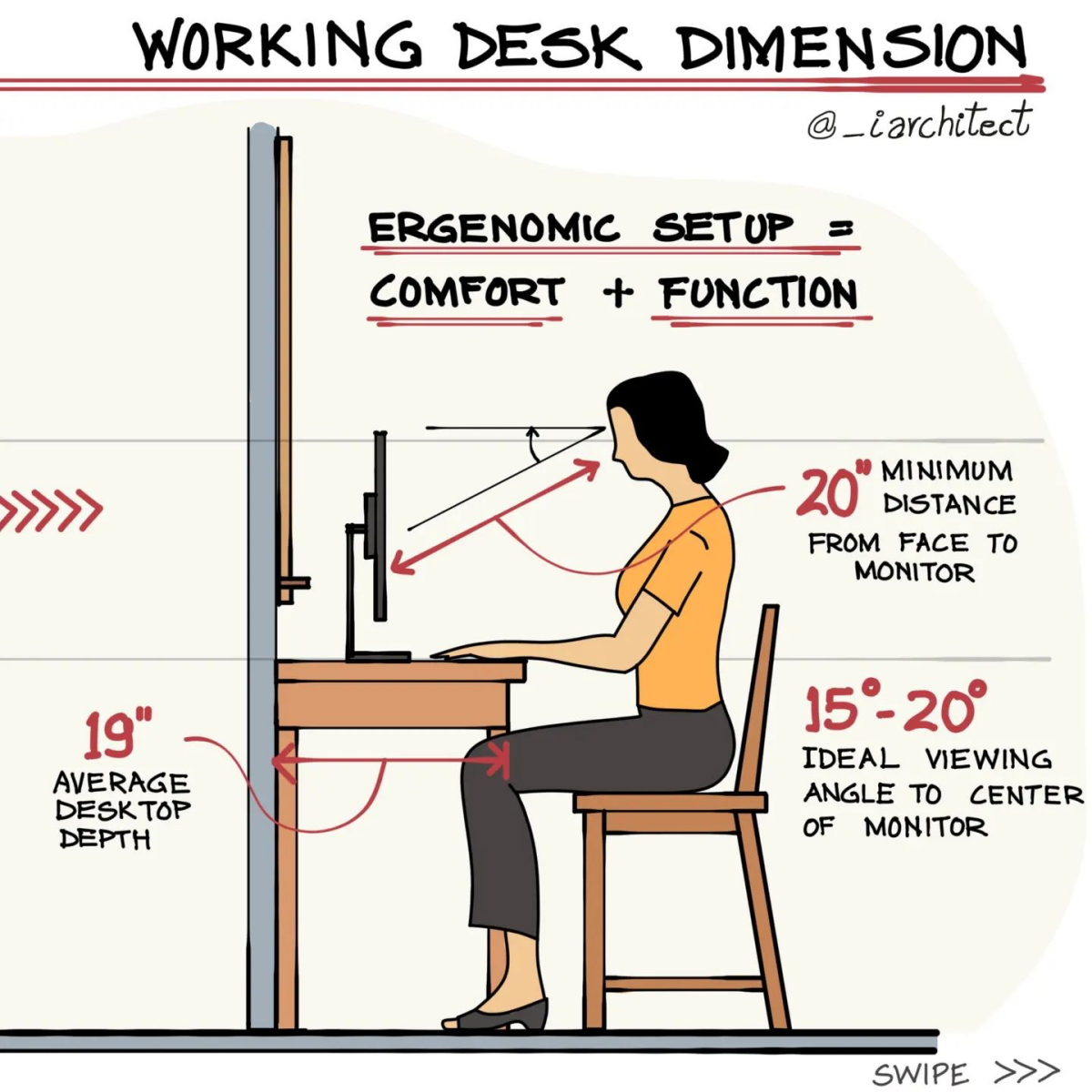
The Foundation: Your Chair, Desk, and Monitor
Now for the big stuff. The heart of any good workspace is what the pros call the “ergonomic triangle”: your chair, your desk, and your monitor. Getting this wrong is the number one reason people end up with back pain, neck strain, and all sorts of repetitive strain injuries. We build this from the ground up, starting with where you sit.
Your Chair: The Most Important Investment You’ll Make
Let’s be real: your chair is the single most critical piece of gear in your office. You spend hours in it every single day. A cheap, unsupportive chair forces your body into weird, unnatural positions. A quality ergonomic chair, on the other hand, adapts to you.
Here’s what you should be looking for:
- Height Adjustability: This is non-negotiable. Your feet need to be flat on the floor with your knees at a 90-degree angle. If your feet are dangling, you’re cutting off circulation. If you’re on the shorter side, a simple footrest (even a small stool or yoga block) can solve this.
- Adjustable Armrests: Your armrests should be high enough that your shoulders can relax and your elbows bend at about 90 degrees. If they’re too high, you’ll be shrugging all day, leading to neck pain. Too low, and they’re basically useless.
- Good Lumbar Support: A great chair has adjustable support that fits right into the curve of your lower back. This is what stops you from slouching, which puts a ton of strain on your spine.
- The Right Seat Depth: You should be able to sit all the way back and still fit two or three fingers between the edge of the seat and the back of your knees. A seat that’s too deep will dig into your legs.
- Swivel and Wheels: Being able to move and pivot freely stops you from twisting your body to reach things. Heads up! Make sure the wheels (casters) are right for your floor. There are different kinds for hard floors and carpets.
A Quick Word on Cost: I know, the sticker shock on high-end ergonomic chairs is real—we’re talking $1,000 or more. But think of it as a health investment that’s built to last a decade or more. If that’s not in the budget, a high-quality refurbished model from a reputable office furniture reseller is an amazing option, often landing in the $400-$600 range. For a tighter budget (say, under $300), look at the higher-end gaming chairs. They often have the same adjustability features—lumbar, armrests, and height—and can be a solid alternative.
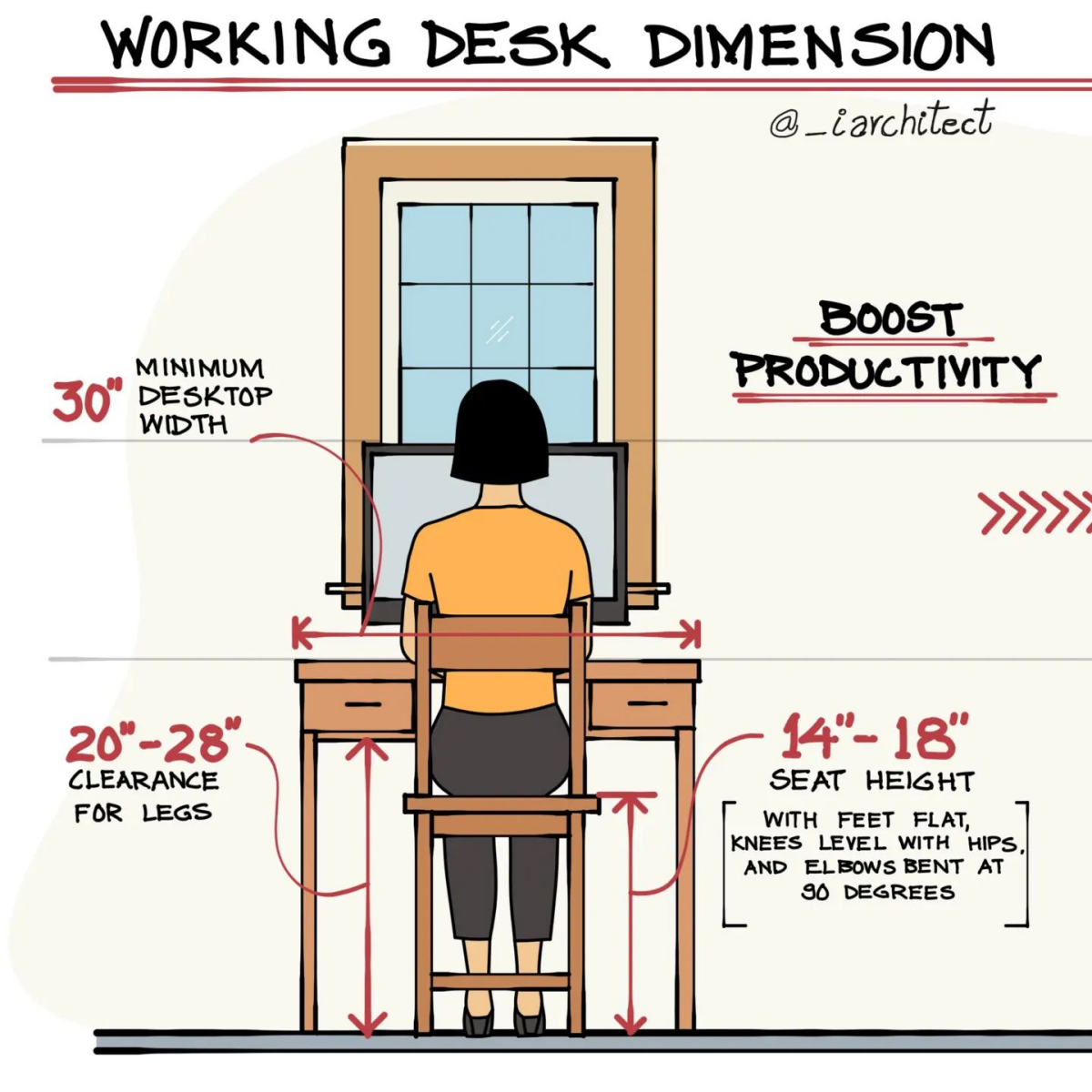
Your Desk: Finding the Right Height
Your desk’s main job is to hold your stuff at the right height. Most standard desks are about 29-30 inches tall, which is perfect… if you’re about 5’11”. For everyone else, adjustments are needed.
Here’s how to find your perfect desk height in 60 seconds. First, adjust your chair properly (feet flat, knees at 90). Sit up straight with relaxed shoulders and bend your elbows to 90 degrees, letting your forearms float parallel to the floor. Now, measure the distance from the floor to your forearms. That measurement is your ideal desk or keyboard tray height. Simple as that.
And what about standing desks? They’re fantastic, but you have to use them right. Standing all day is just as bad as sitting all day. I tell my clients to alternate, maybe standing for 30 minutes every couple of hours. The height principle is the same: adjust the desk so your elbows are at a 90-degree angle. Oh, and an anti-fatigue mat isn’t a luxury; it’s essential for standing comfortably and costs about $30-$50. Your feet and back will thank you.
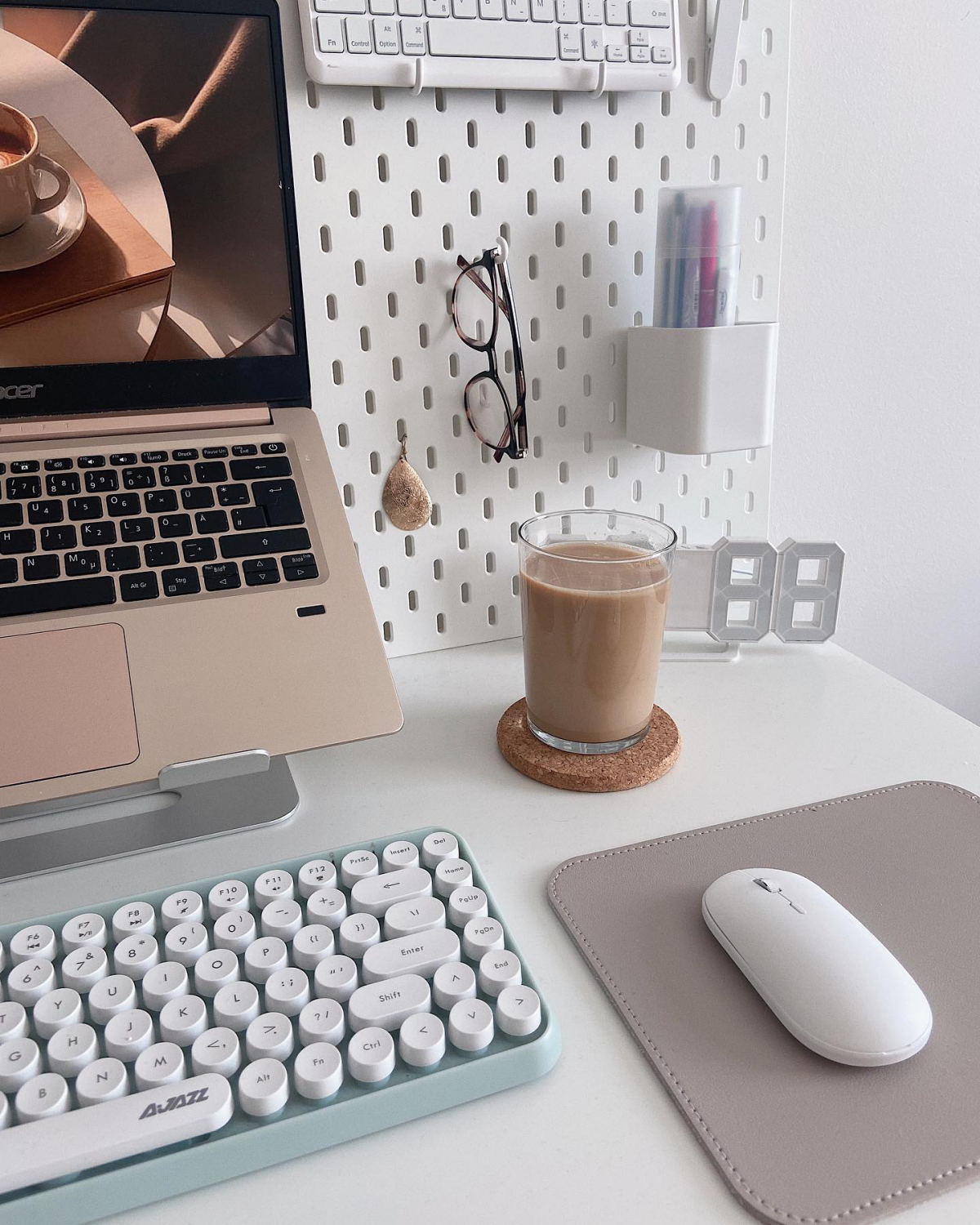
Your Monitor: Stop Hunching Over
As we covered, working directly on a laptop for hours is a one-way ticket to Neck Pain City. An external monitor is an absolute must-have.
Positioning is everything. Sit back and stretch your arm out—your fingertips should just about touch the screen. For height, the top edge of the monitor should be at or slightly below your eye level. A monitor arm is a total game-changer here. A good one will set you back about $50 to $100 and gives you complete control over height, depth, and angle. It’s one of the best upgrades you can make for the money.
Creating the Right Vibe: Light & Sound
Your immediate workspace is sorted, but the environment around you matters just as much. Getting the light and sound right can be the difference between feeling focused and feeling frazzled.
A Three-Layer Approach to Lighting
Bad lighting doesn’t just cause eye strain; it can kill your mood and energy. I always recommend a simple three-layer approach:
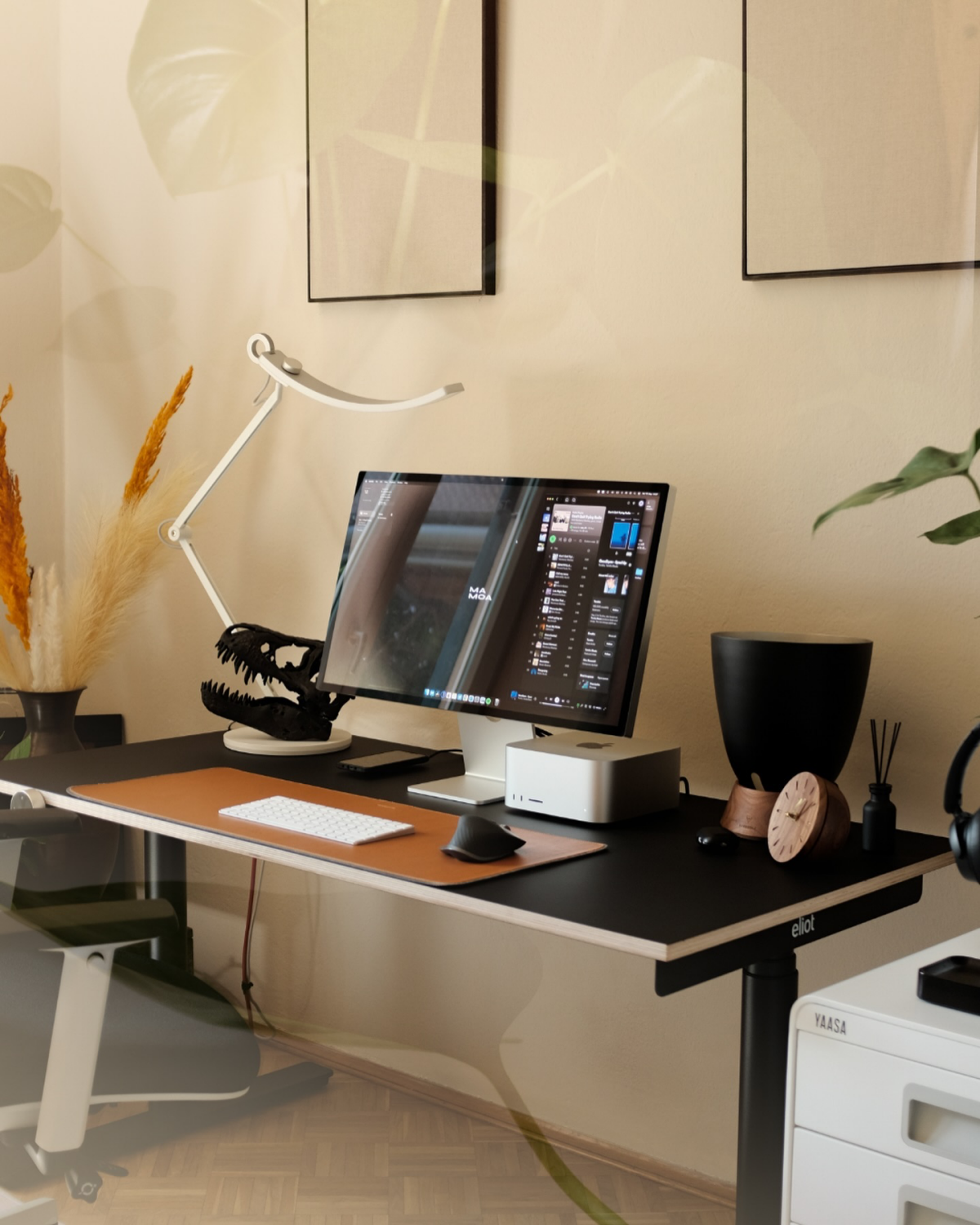
- Ambient Light: This is your room’s overall light, usually from a ceiling fixture. It should be bright enough to prevent harsh shadows and reduce the stark contrast between your bright screen and a dark room.
- Task Light: This is a focused light for your desk. A good, adjustable desk lamp is essential for illuminating papers without causing glare on your screen. You can find great LED options for $30-$70. Look for something around 500-700 lumens with a neutral color temperature (3000K to 4000K is perfect) to keep you alert.
- Natural Light: Nothing beats daylight. If you can, place your desk perpendicular to a window. This gives you nice, soft light from the side. Facing a window can cause glare, and having one behind you will create reflections on your screen. If you can’t avoid it, some simple blinds or a sheer curtain will do the trick.
A Quieter Workspace
Unless you live alone in the middle of nowhere, household noises are a fact of life. But you can do a lot to absorb sound. A simple rug on a hard floor, some curtains, or even a fabric pinboard can help dampen echoes. For really noisy spots, a few strategically placed acoustic foam panels can make a huge difference, and they don’t have to cover the whole wall.
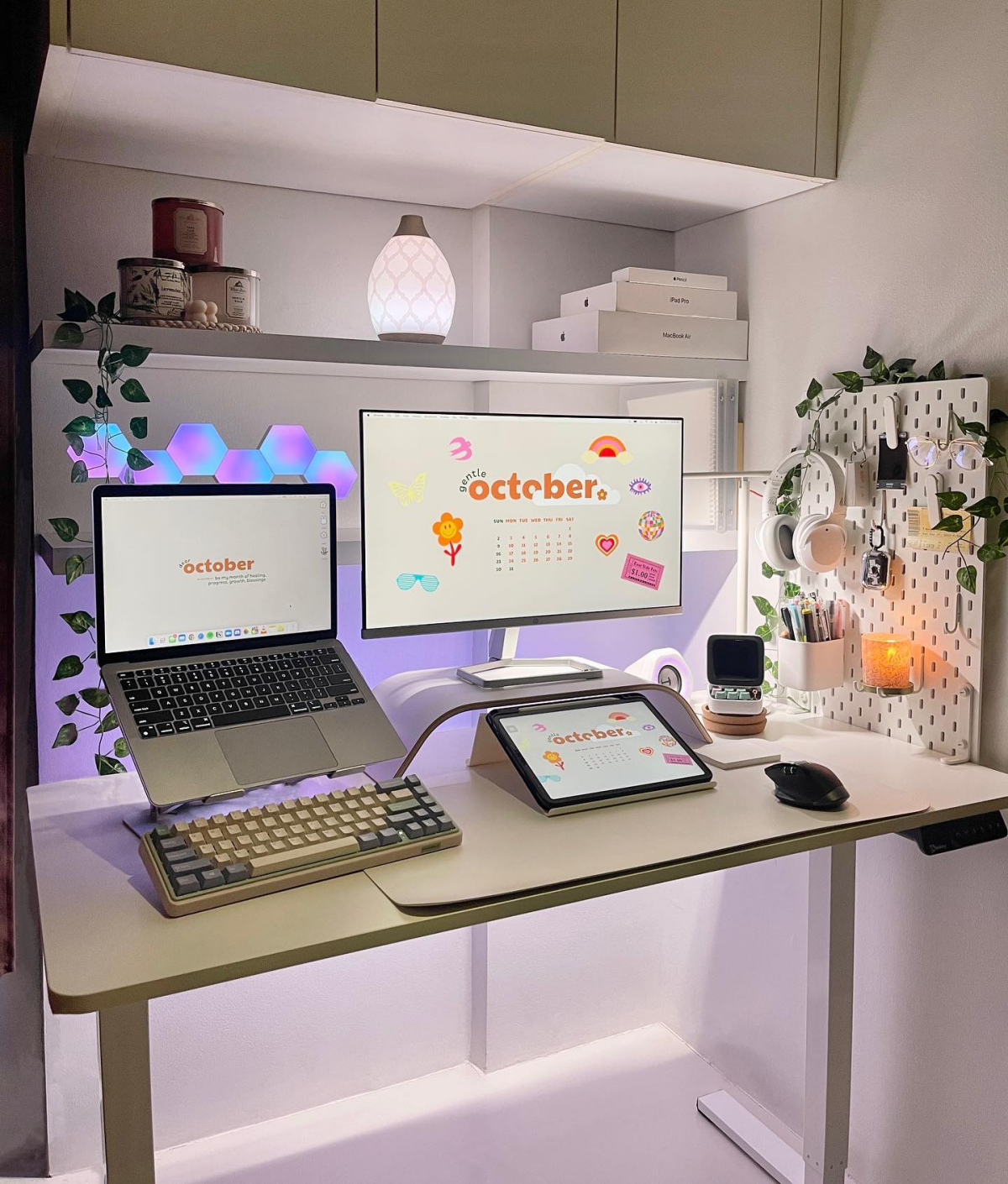
The Tools of the Trade: Gear & Organization
Okay, the foundation is solid. Now we can look at the tools you touch all day and how to keep them from taking over your desk.
Professional-Level Cable Management
Tangled cables aren’t just ugly; they’re a distraction and a safety hazard. Taming them is the mark of a truly pro setup. From my experience, you can build a fantastic cable-taming kit for under $30.
My go-to shopping list: a pack of reusable velcro ties (about $8), an under-desk cable tray or basket to hide your power strip ($15), and a pack of adhesive cable clips for routing cords neatly ($5). You can find all this online or at any big-box hardware store.
Quick safety warning: Never, ever plug one power strip into another. It’s called “daisy-chaining,” and it’s a serious fire risk. Use a single, high-quality surge protector with enough outlets for your gear.
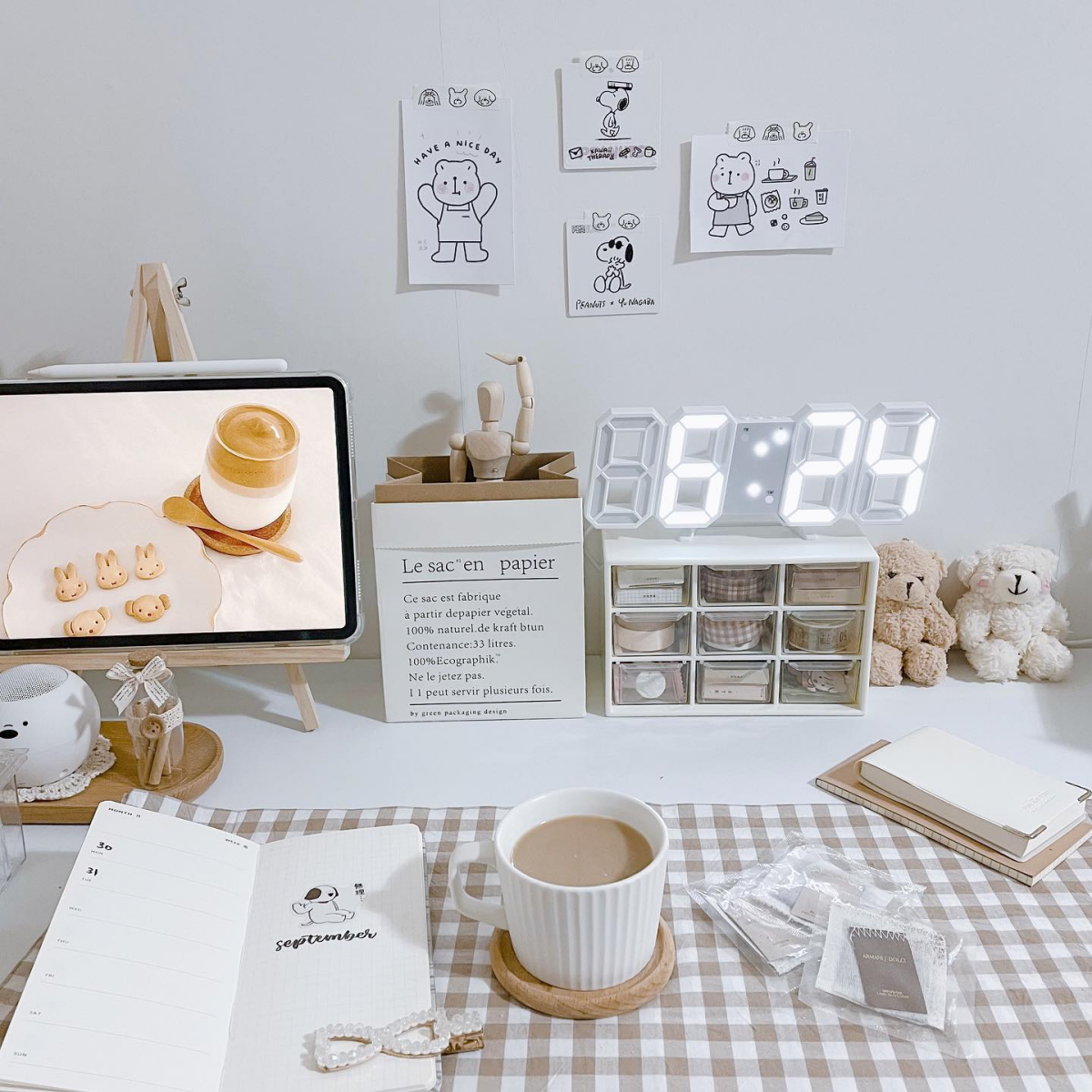
Storage and Workflow
The rule for an organized desk is simple: keep what you use daily within arm’s reach. Everything else needs a home. Use your vertical space! Shelves above the desk are perfect for books and binders. A small set of drawers can hold your stationery. The goal is to keep your main work surface clear for the task at hand, which does wonders for your mental clarity.
When to Call a Professional
Building a great home office is a journey. You can assemble a chair and manage your cables, for sure. But it’s also important to know your limits. If your lights flicker when your printer turns on, or a breaker keeps tripping, that’s a job for a licensed electrician. Don’t mess with that stuff. Likewise, if you want custom built-in shelves, a good carpenter will do the job safely and beautifully.
By focusing on function first, you create a workspace that doesn’t just look good, but actively supports your health, your focus, and your best work for years to come.
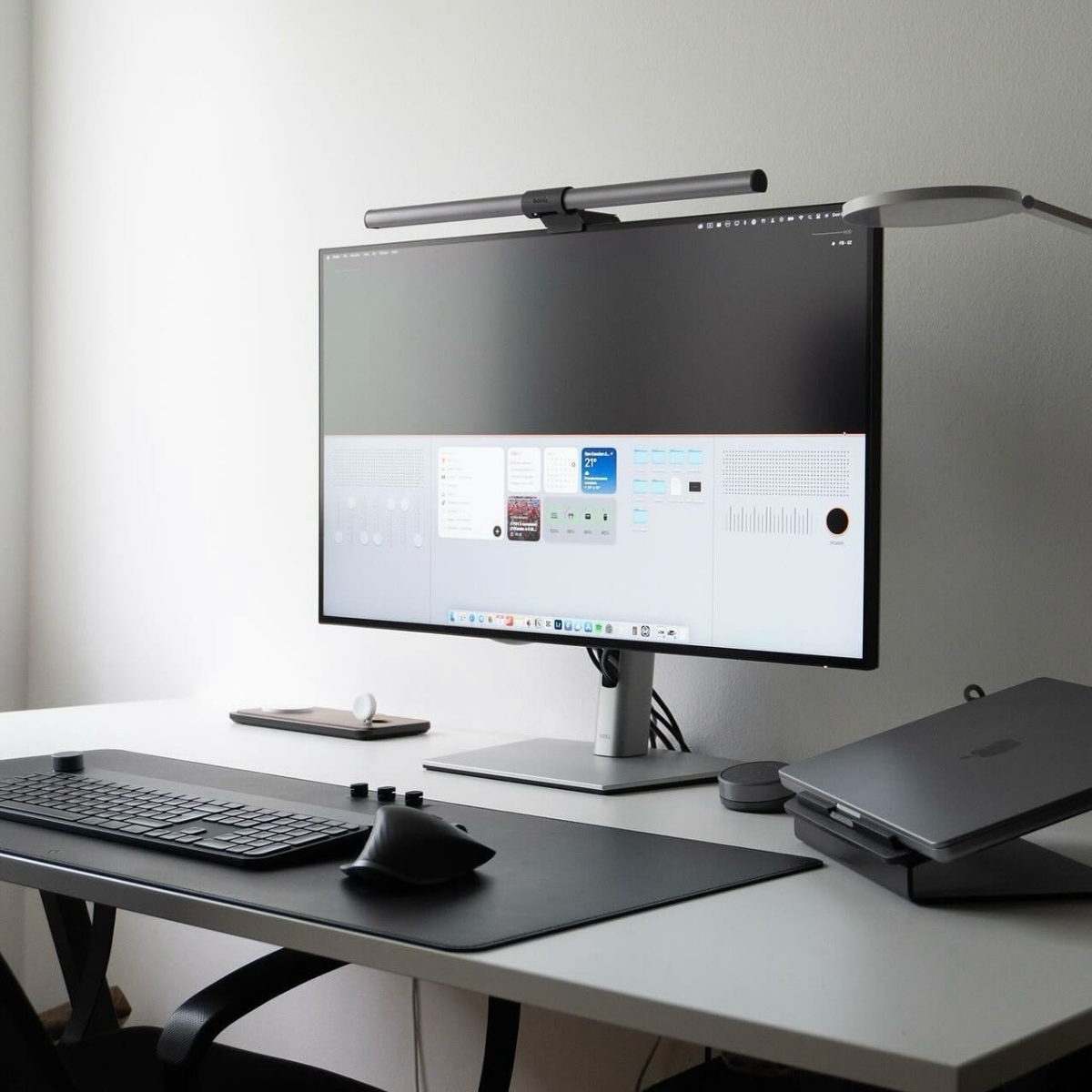
Galerie d’inspiration
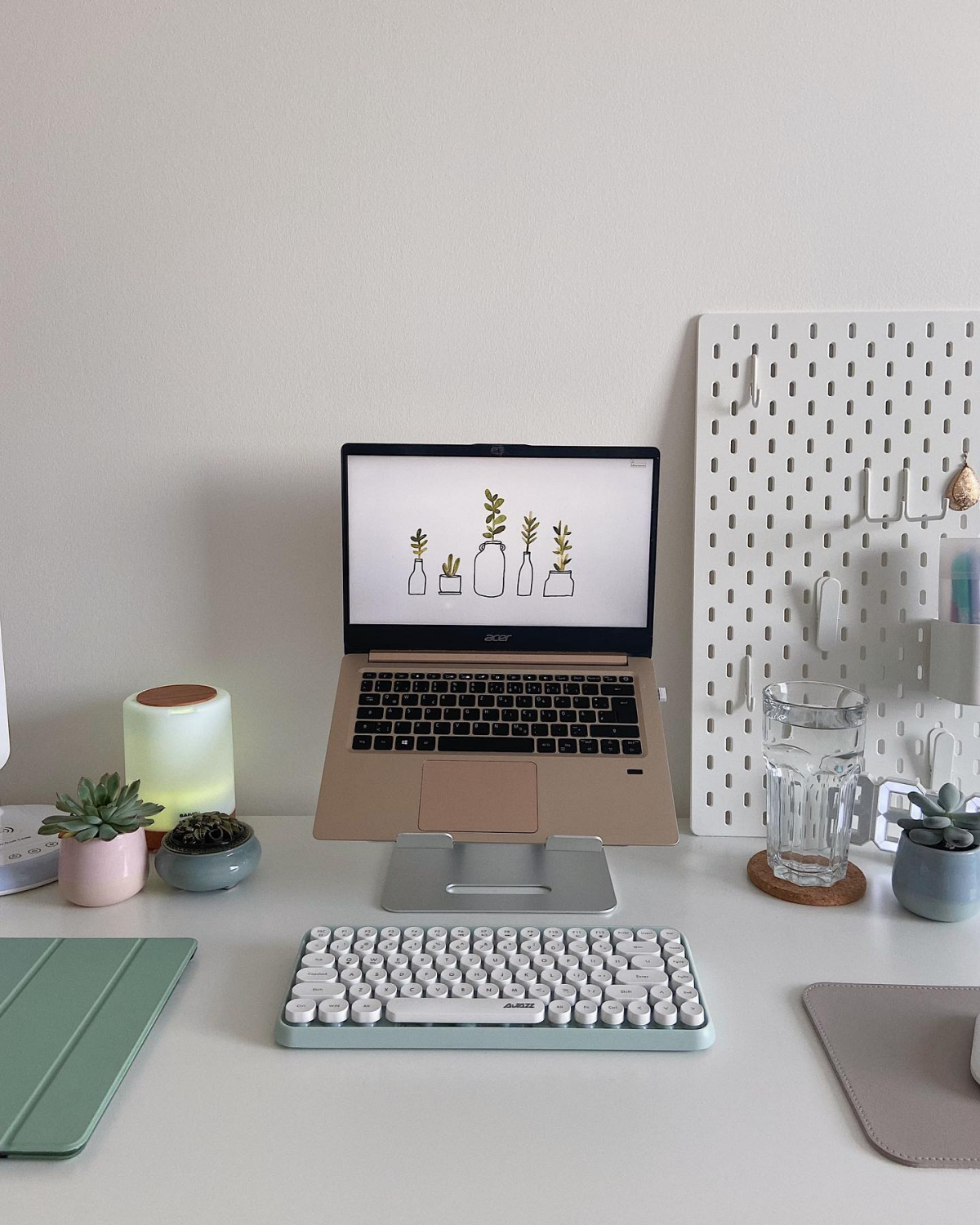
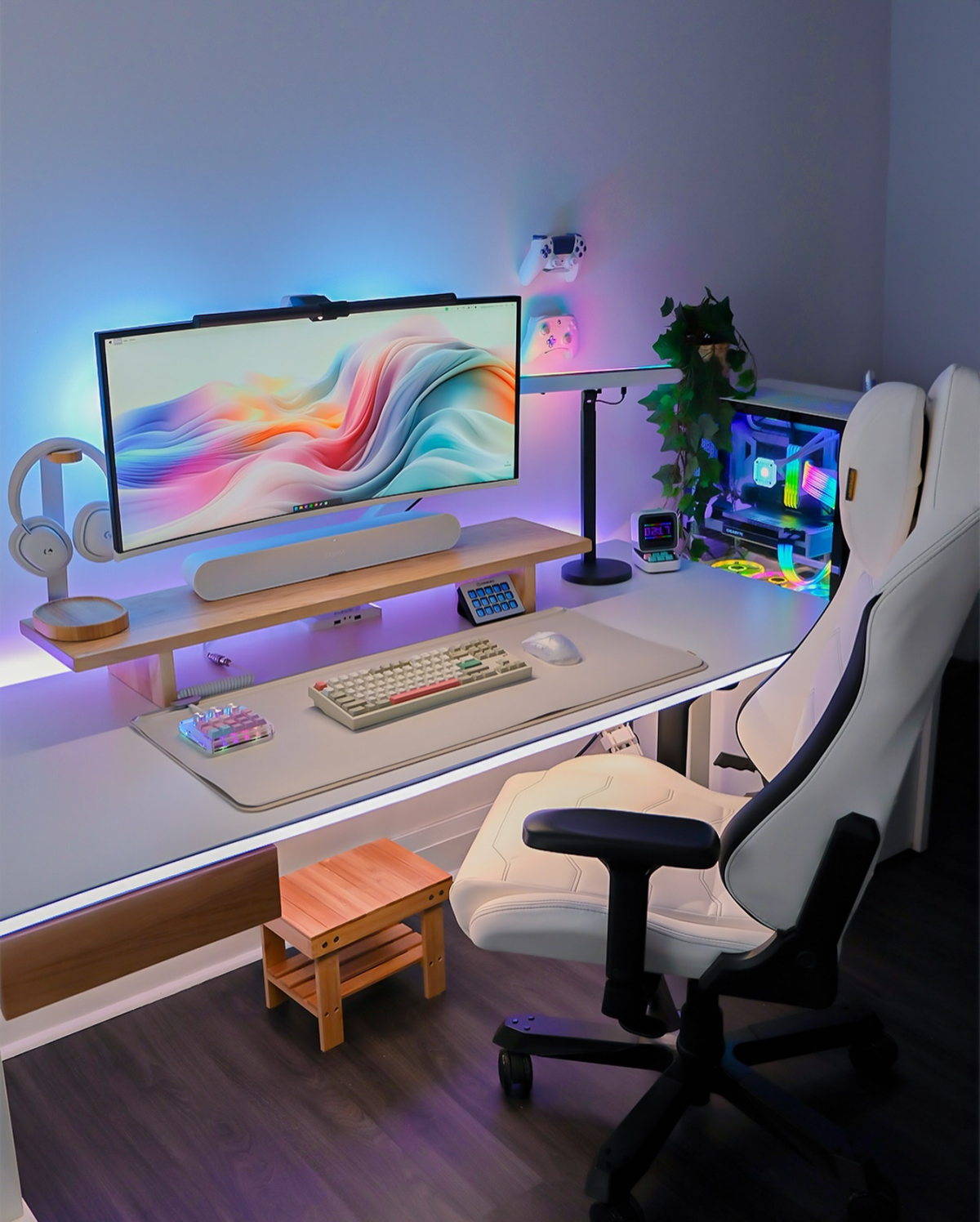
Standing Desk: A full, dedicated desk that rises and lowers, often electronically. It offers maximum stability and a clean, integrated look. Ideal for a permanent, long-term setup.
Desktop Converter: A unit that sits on your existing desk, allowing you to raise your monitor and keyboard. It’s a more affordable, flexible entry into the standing world.
For trying the trend, a converter like those from Vari is perfect. For a full commitment, an automated desk from a brand like Uplift Desk is a game-changer.
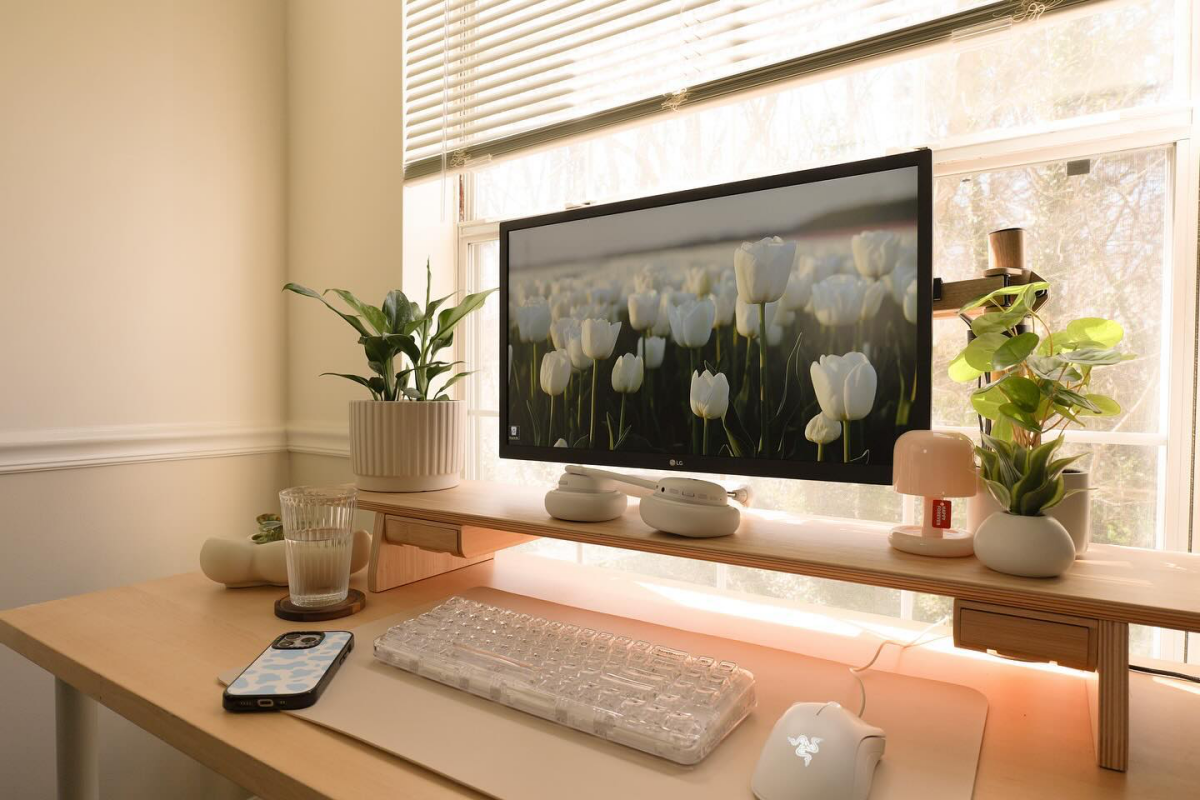
According to a study in the Annals of Internal Medicine, prolonged sitting is associated with a higher risk of heart disease, diabetes, and even cancer, regardless of whether you exercise regularly.
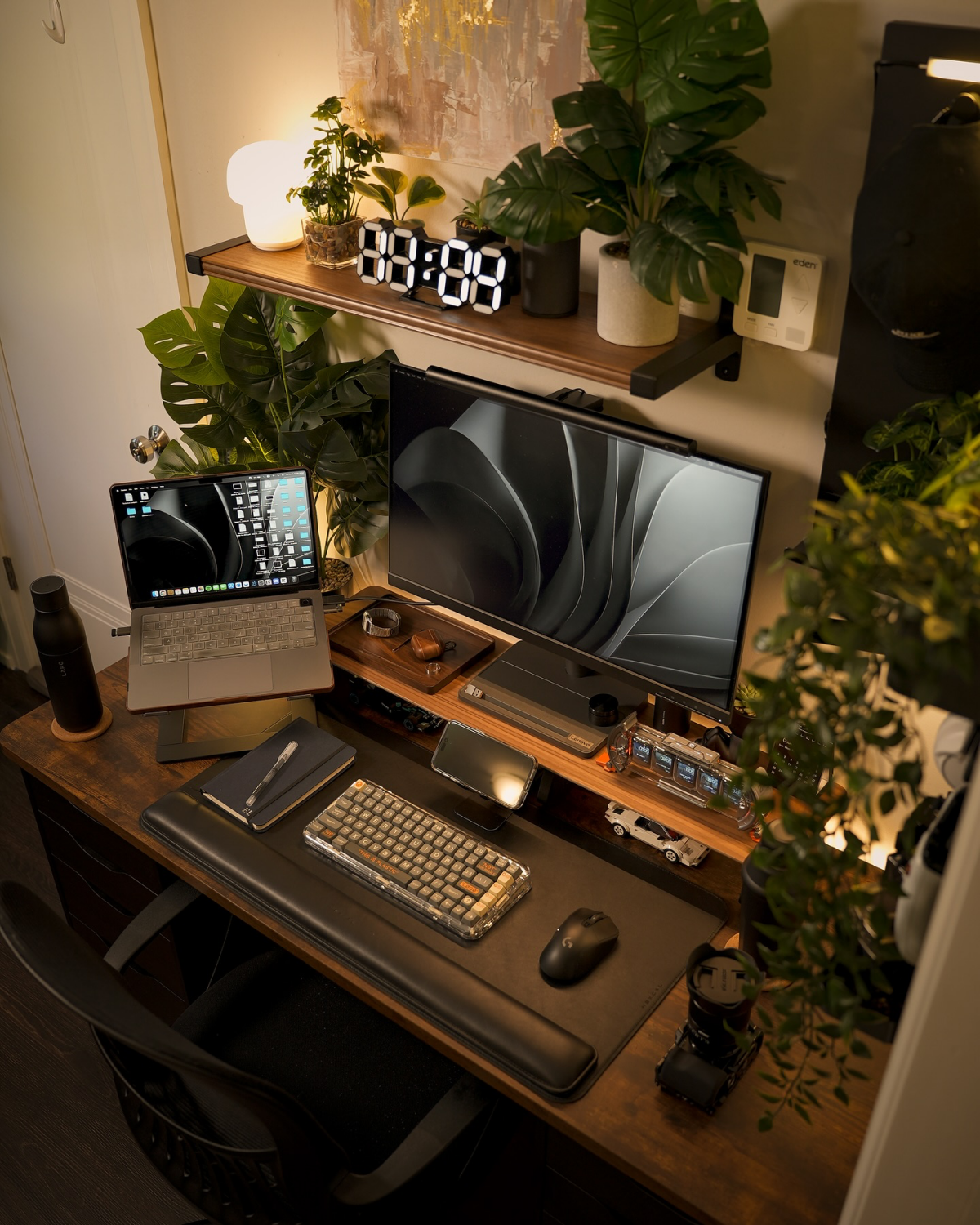
Tangled cables are more than just an eyesore; they’re a hazard and a hassle. Reclaim your space with a few simple tools:
- Cable Sleeves: Bundle all the cords running from your desk into one neat tube.
- Under-Desk Power Strip: Mount a power strip to the underside of your desk to keep all plugs hidden and off the floor.
- Velcro Ties: Infinitely better than single-use plastic zip ties for managing bundles and securing excess cord length.
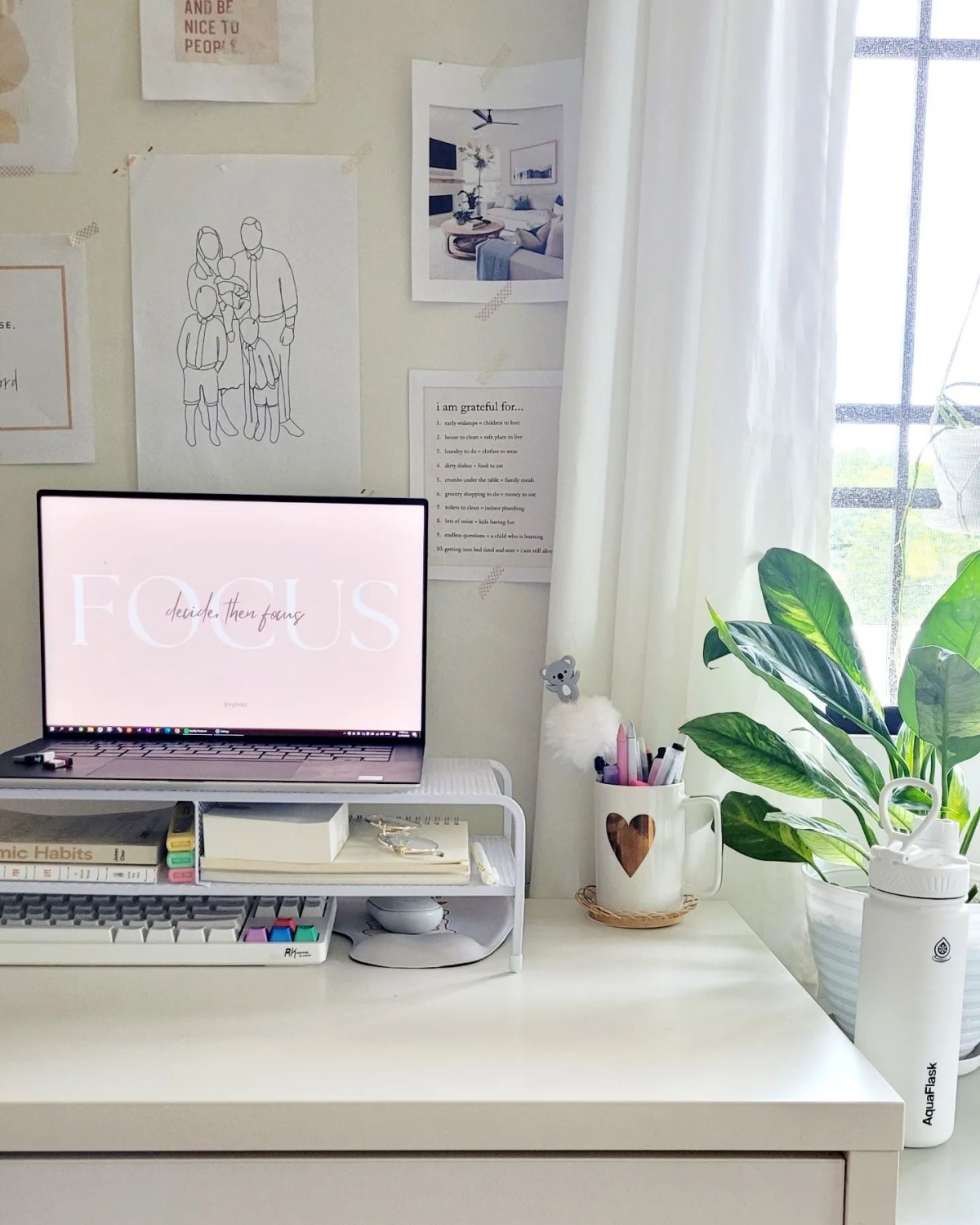
The one thing people always get wrong: Lighting. A single overhead light creates glare and eye strain. A proper setup requires layers. Use a main ambient light for the room, but add a dedicated task lamp on your desk. A monitor light bar, like the BenQ ScreenBar, is a brilliant solution that illuminates your desk without creating glare on your screen.
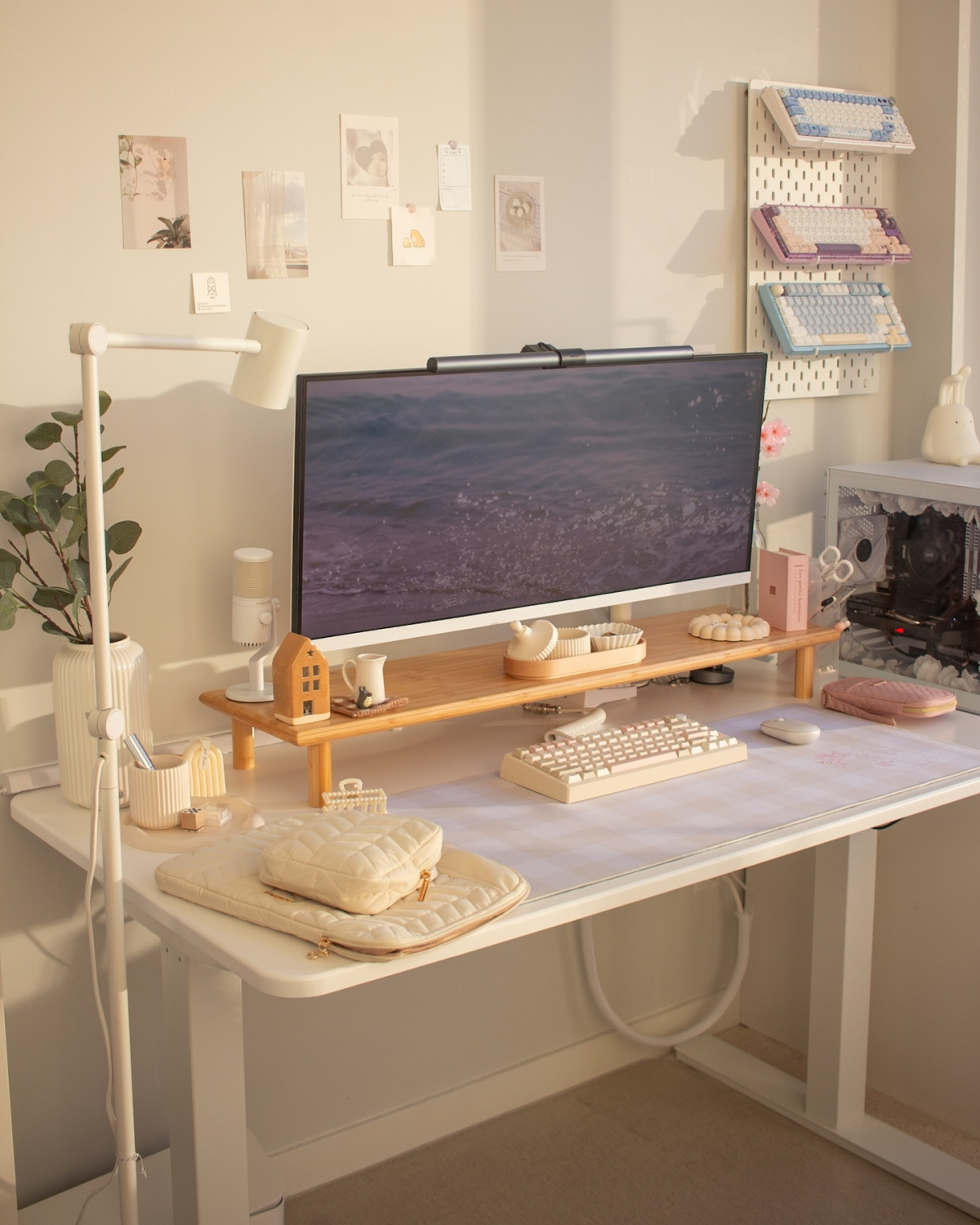
An expensive ergonomic chair from brands like Herman Miller or Steelcase… is it really worth it?
Yes, if you view it as a long-term investment in your health. The value isn’t just in the name; it’s in the decade-plus warranty and the hyper-specific adjustability. The ability to fine-tune lumbar support, armrest height and angle, and seat depth to your exact body is what prevents pain. While a solid budget option like the IKEA Markus is a good start, a premium chair is engineered to provide dynamic support for 8+ hours a day, year after year.
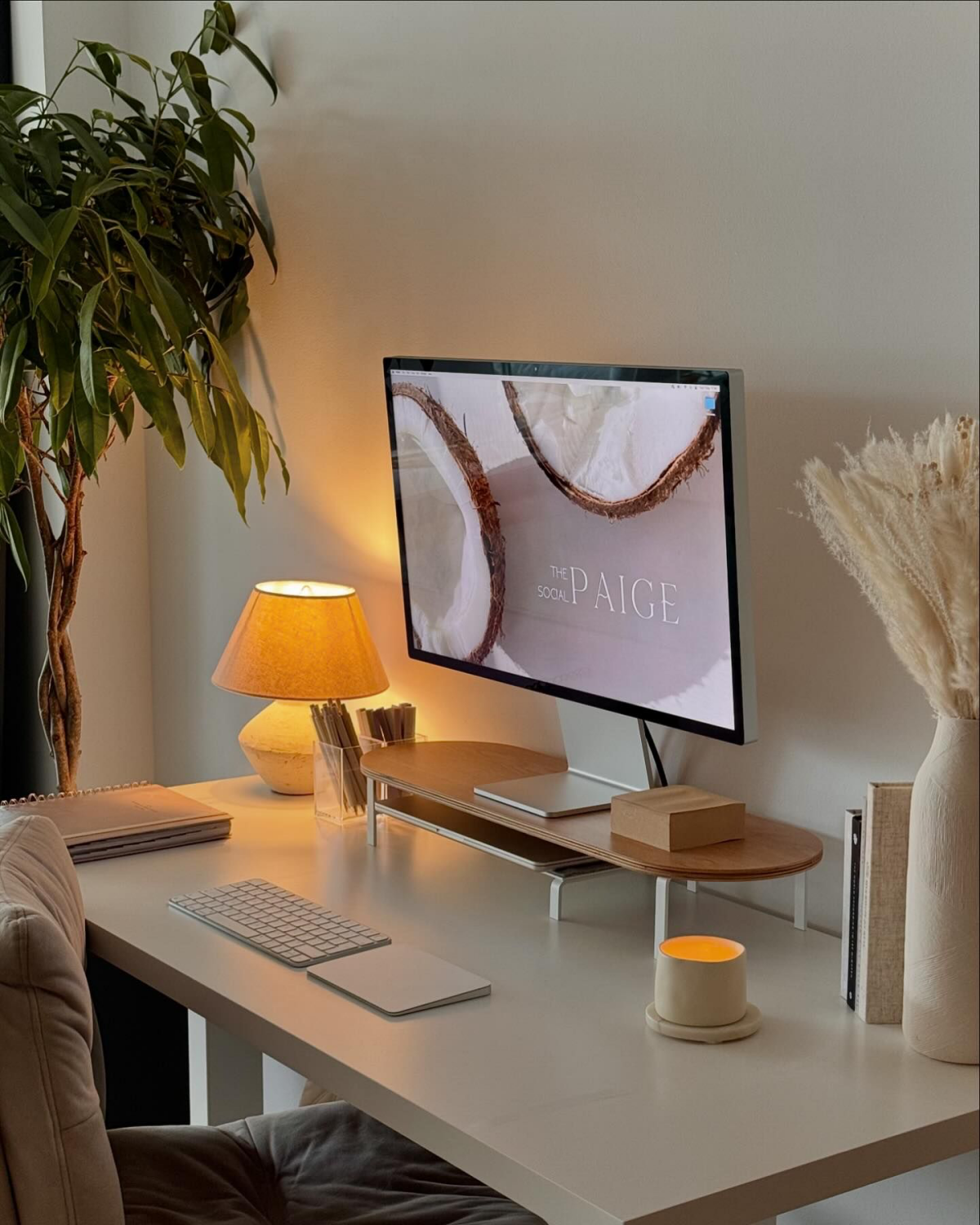
Researchers at the University of Exeter found that enriching an office with plants can increase productivity by 15%.
This is the power of biophilic design. It’s more than decoration; connecting with nature, even just with a small succulent or a low-maintenance snake plant on your desk, is proven to reduce stress, improve concentration, and give your eyes a necessary break from the screen’s blue light.
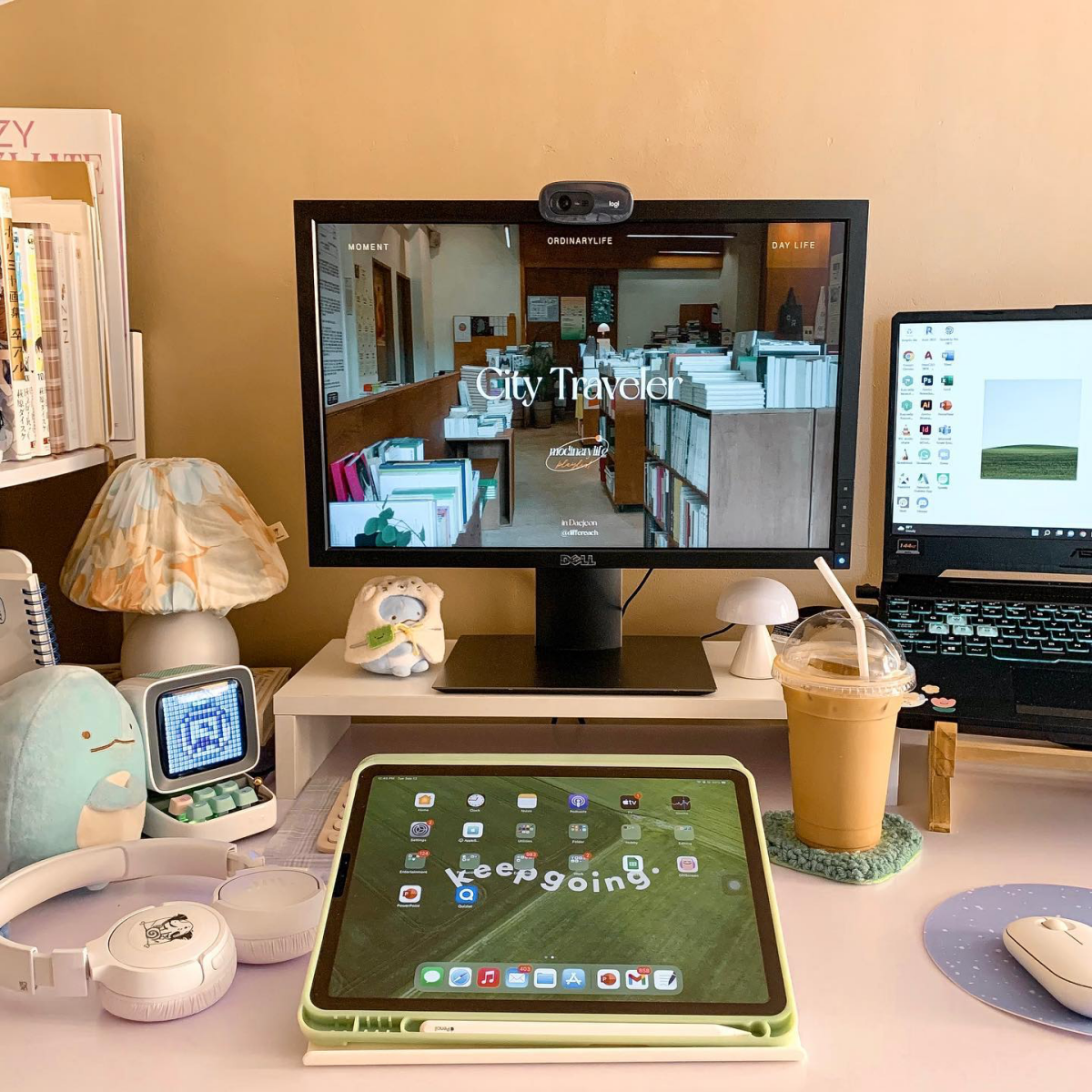
When your office is a corner of your living room, the goal is integration, not isolation. Choose a desk with warmer materials like wood or bamboo to match your home’s furniture. Select a chair that combines ergonomics with style—many brands now offer models in various fabrics and colors. Finally, use accessories like a ceramic pen holder or a stylish tray to hold small items, connecting the workspace to your overall home aesthetic.
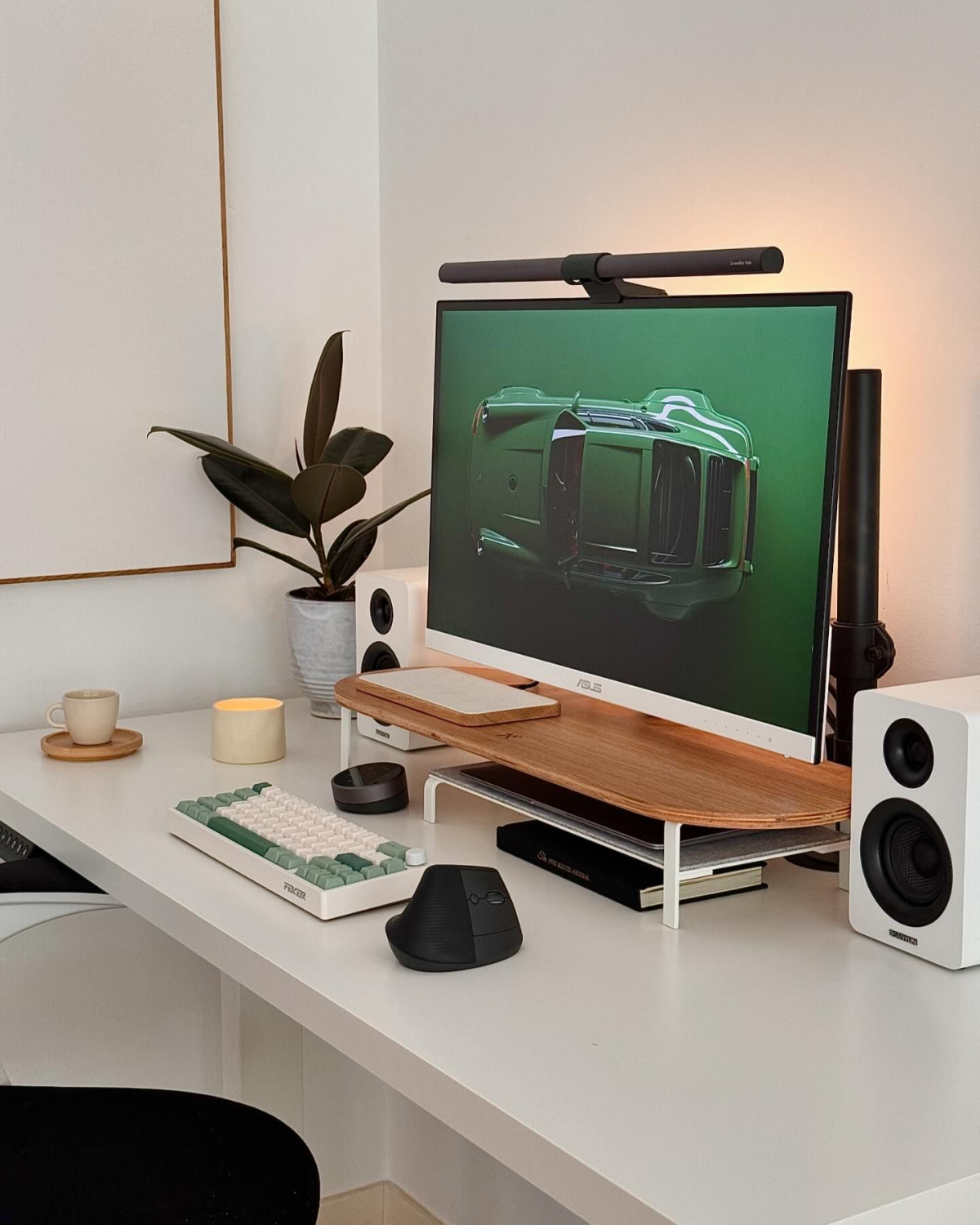
- A desk surface that stays clear and focused.
- Your headphones, notebooks, and essential tools are always within reach.
- A dedicated space for inspiration, photos, or key reminders.
The secret? Look up. Using vertical space with a simple pegboard system like IKEA’s SKÅDIS or a pair of floating wall shelves turns an empty wall into your most valuable organizational asset.
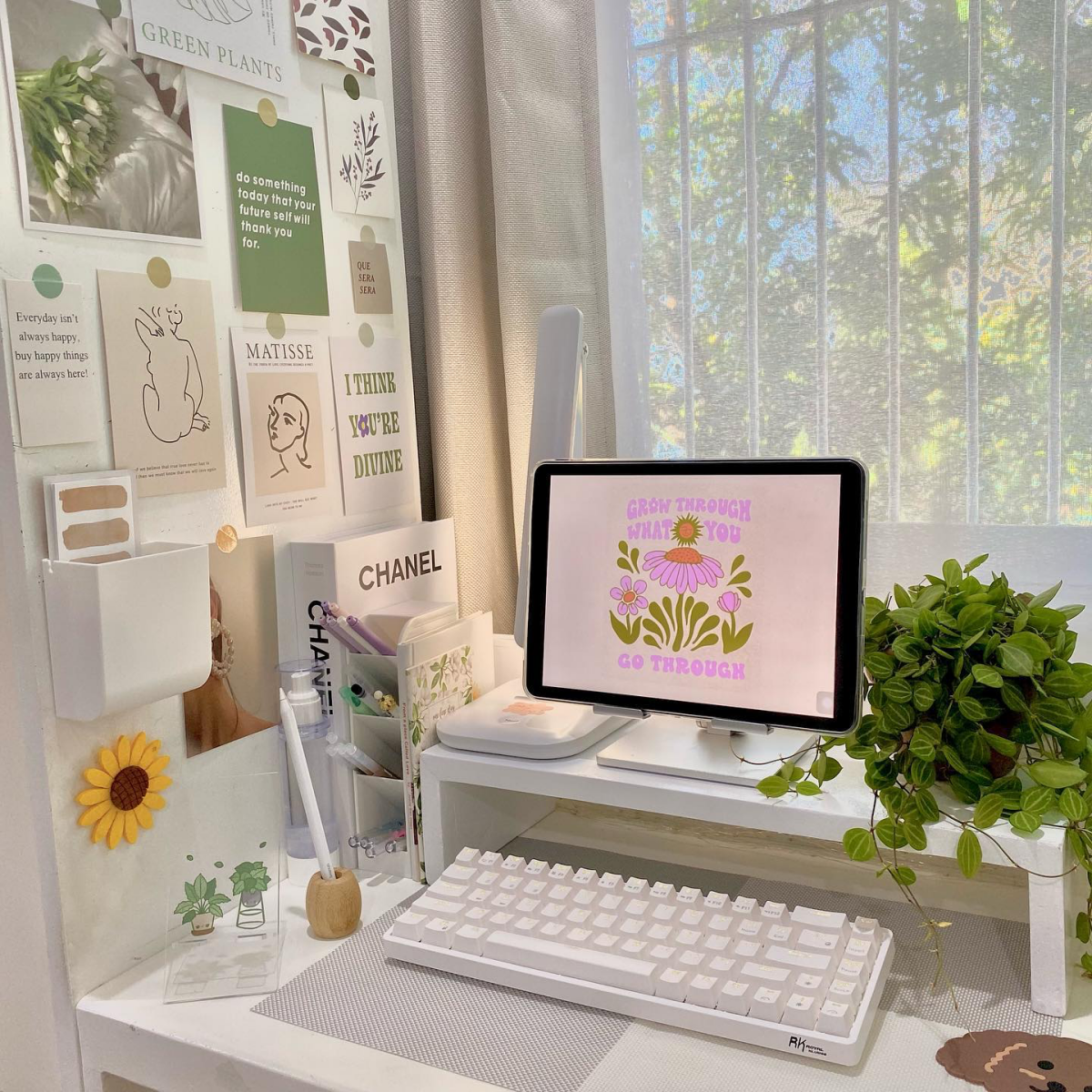
Don’t underestimate your soundscape. In a bustling household, a good pair of noise-canceling headphones, such as the Bose QuietComfort or Sony WH-1000XM5, can create an invaluable bubble of pure focus. If total silence feels unnatural, an app like ‘myNoise’ can generate ambient sounds—from a gentle rain to a distant coffee shop—to mask distracting noises and help you concentrate.
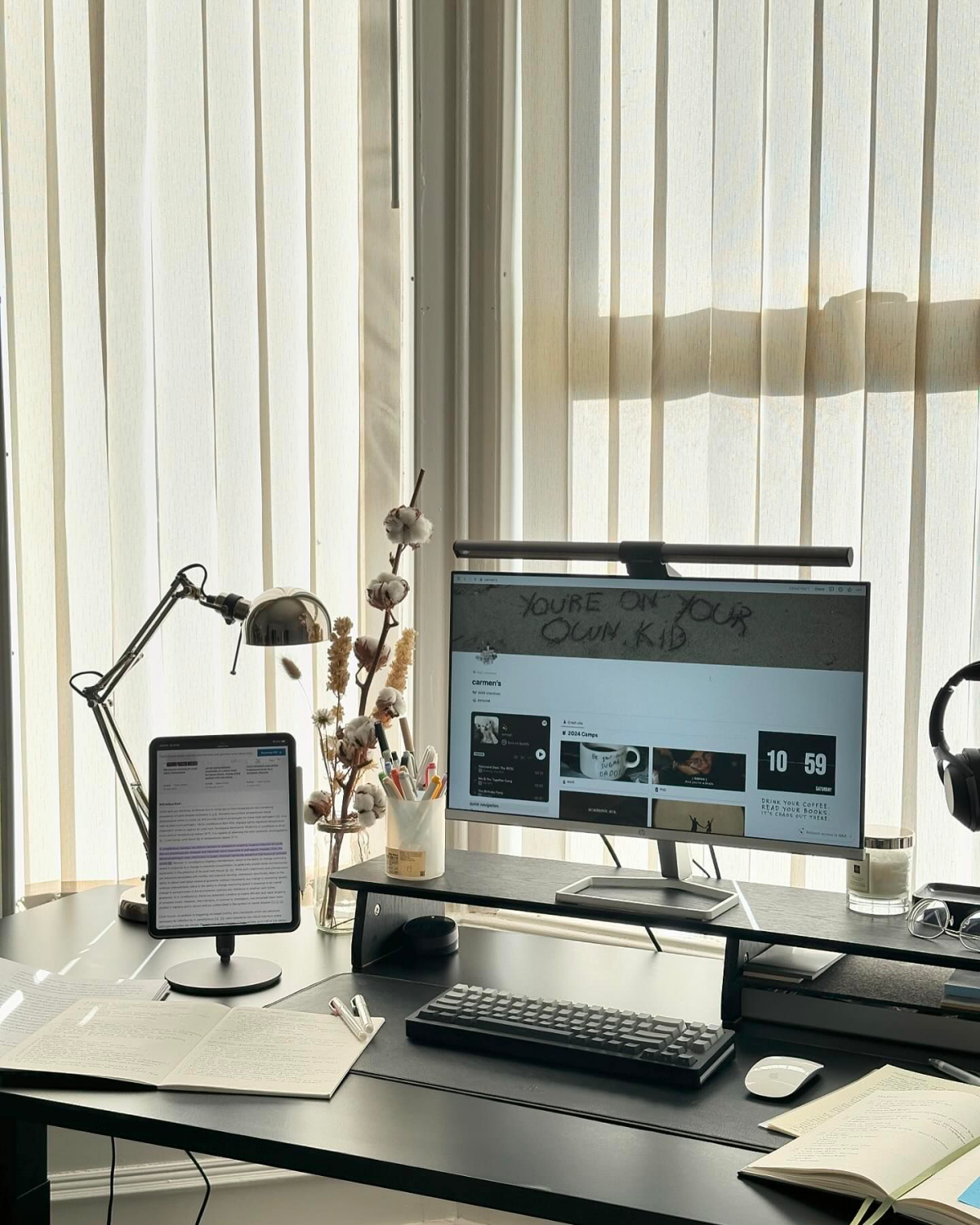
As screens get bigger, the big question is no longer ‘one monitor or two?’. It’s about what best suits your workflow.
- Dual Monitors: Perfect for multitasking with clearly defined spaces. For example, keeping your communication apps on one screen and your primary work on the other. It’s often a more budget-friendly setup.
- One Ultrawide Monitor: Offers a seamless, cinematic canvas without a bezel breaking your view. It’s a dream for video editing, complex spreadsheets, or anyone who needs to see multiple windows side-by-side on a single project.

A classic beginner’s mistake is allocating the budget backward. People often splurge on a beautiful, expensive desk and then buy a cheap, unsupportive chair. Your desk is a passive surface. Your chair is an active tool that interacts with your body for hours. If money is tight, invest in the best ergonomic chair you can afford (even a refurbished one from a top brand) and place it at a simple, sturdy dining table. Your back and neck will thank you.
The essence of interior design will always be about people and how they live. It is about the realities of what makes for an attractive, civilized, meaningful environment, not about fashion or what’s in or what’s out.










